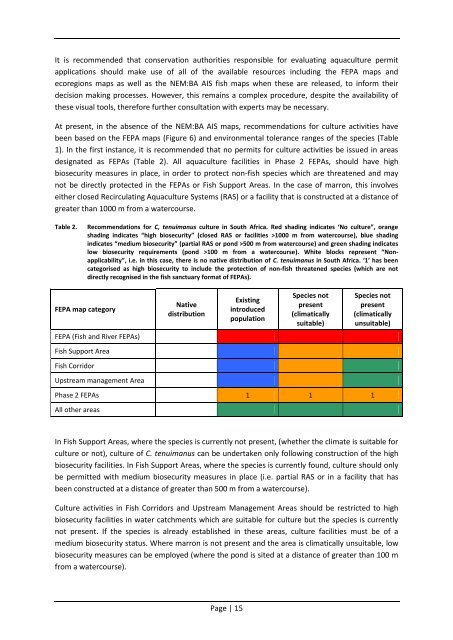Marron, freshwater crayfish Cherax tenuimanus - Department of ...
Marron, freshwater crayfish Cherax tenuimanus - Department of ...
Marron, freshwater crayfish Cherax tenuimanus - Department of ...
Create successful ePaper yourself
Turn your PDF publications into a flip-book with our unique Google optimized e-Paper software.
It is recommended that conservation authorities responsible for evaluating aquaculture permit<br />
applications should make use <strong>of</strong> all <strong>of</strong> the available resources including the FEPA maps and<br />
ecoregions maps as well as the NEM:BA AIS fish maps when these are released, to inform their<br />
decision making processes. However, this remains a complex procedure, despite the availability <strong>of</strong><br />
these visual tools, therefore further consultation with experts may be necessary.<br />
At present, in the absence <strong>of</strong> the NEM:BA AIS maps, recommendations for culture activities have<br />
been based on the FEPA maps (Figure 6) and environmental tolerance ranges <strong>of</strong> the species (Table<br />
1). In the first instance, it is recommended that no permits for culture activities be issued in areas<br />
designated as FEPAs (Table 2). All aquaculture facilities in Phase 2 FEPAs, should have high<br />
biosecurity measures in place, in order to protect non-fish species which are threatened and may<br />
not be directly protected in the FEPAs or Fish Support Areas. In the case <strong>of</strong> marron, this involves<br />
either closed Recirculating Aquaculture Systems (RAS) or a facility that is constructed at a distance <strong>of</strong><br />
greater than 1000 m from a watercourse.<br />
Table 2.<br />
Recommendations for C, <strong>tenuimanus</strong> culture in South Africa. Red shading indicates ‘No culture”, orange<br />
shading indicates “high biosecurity” (closed RAS or facilities >1000 m from watercourse), blue shading<br />
indicates “medium biosecurity” (partial RAS or pond >500 m from watercourse) and green shading indicates<br />
low biosecurity requirements (pond >100 m from a watercourse). White blocks represent “Nonapplicability”,<br />
i.e. in this case, there is no native distribution <strong>of</strong> C. <strong>tenuimanus</strong> in South Africa. ‘1’ has been<br />
categorised as high biosecurity to include the protection <strong>of</strong> non-fish threatened species (which are not<br />
directly recognised in the fish sanctuary format <strong>of</strong> FEPAs).<br />
FEPA map category<br />
Native<br />
distribution<br />
Existing<br />
introduced<br />
population<br />
Species not<br />
present<br />
(climatically<br />
suitable)<br />
Species not<br />
present<br />
(climatically<br />
unsuitable)<br />
FEPA (Fish and River FEPAs)<br />
Fish Support Area<br />
Fish Corridor<br />
Upstream management Area<br />
Phase 2 FEPAs 1 1 1<br />
All other areas<br />
In Fish Support Areas, where the species is currently not present, (whether the climate is suitable for<br />
culture or not), culture <strong>of</strong> C. <strong>tenuimanus</strong> can be undertaken only following construction <strong>of</strong> the high<br />
biosecurity facilities. In Fish Support Areas, where the species is currently found, culture should only<br />
be permitted with medium biosecurity measures in place (i.e. partial RAS or in a facility that has<br />
been constructed at a distance <strong>of</strong> greater than 500 m from a watercourse).<br />
Culture activities in Fish Corridors and Upstream Management Areas should be restricted to high<br />
biosecurity facilities in water catchments which are suitable for culture but the species is currently<br />
not present. If the species is already established in these areas, culture facilities must be <strong>of</strong> a<br />
medium biosecurity status. Where marron is not present and the area is climatically unsuitable, low<br />
biosecurity measures can be employed (where the pond is sited at a distance <strong>of</strong> greater than 100 m<br />
from a watercourse).<br />
Page | 15
















